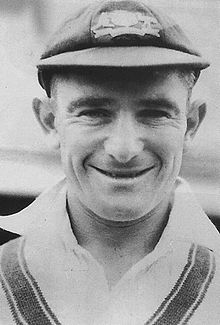Cricket cap

A cricket cap is a type of soft cap, often made from felt that is a traditional form of headwear for players of the game of cricket, regardless of age or gender. It is usually a tight-fitting skullcap, usually made of six or eight sections, with a small crescent shaped brim that points downwards over the brow to provide shade for the eyes. It is often, but not always, elasticised at the rear to hold it in place upon the wearer's head. Sometimes, rather than tight-fitting, the cricket cap comes in a baggy variety, that is always kept in place by elastic.
Description
The style of cap is also often used as official headwear as part of school uniforms for boys from private schools, particularly in the United Kingdom and throughout the Commonwealth of Nations. Although not common in the modern period, the cricket cap used to be a fashionable form of headwear for people who were casually dressed, and not necessarily worn just for playing the game.
Cricket caps are usually, but not always multi-coloured in the colours of the cricket club or school for which the cap is designed to represent. Sometimes they are particularly elaborately patterned with different sections in different colours, or different coloured rings or hoops around them. At international level, the cap is traditionally made from a single colour. However, in recent years in particular, many cricket teams, particularly for limited overs cricket have opted to wear baseball caps, rather than traditional cricket caps, but the style is still quite popular for first-class cricket teams, as well as Test cricket sides.
The origins of the cricket cap are hard to discern, however prints showing the game being played in the eighteenth century, already depict players wearing a variety similar versions of the traditional cricket cap.
Perhaps the most famous version of the cricket cap in the modern setting is the baggy green cricket cap of the Australian cricket team, for which the players and fans of Australia hold a degree of reverence. The cap is treated with a degree of mysticism, and players who have long careers often refuse to replace the original one they receive as they often feel the cap is a lucky talisman. This sometimes results in players who have long careers wearing their cricket caps in quite a tattered state. The Australian side has long worn their baggy cricket cap, rather than alternatives such as a sun hat, for the first session of each match as a symbol of team solidarity.
Players who represent first-class or Test match cricket sides are often presented with a cap ceremonially before their debut. This is called "receiving their first cap". The cap is numbered according to how many players have represented that side before them. For example, Indian cricketer Sachin Tendulkar was the 187th player to represent India at Test level, and was awarded cap number 187. It is also sometimes used to refer to the number of time a player has played. Tendulkar played 200 Tests for India, so therefore he is said to have received 200 caps. While an actual cap may not necessarily be presented on every occasion, ceremonial cap presentations are often made for milestone appearances such as a player's 50th or 100th Test, in addition to debuts.
Famous colours
International Test cricket

- Australia – Baggy green
- Bangladesh – Dark green
- England – Navy blue
- India – Navy blue
- New Zealand – Black
- Pakistan – Dark green
- Sri Lanka – Dark blue
- South Africa – Dark green
- West Indies – Maroon
- Zimbabwe – Dark green in first class matches, Scarlet
Players from Bangladesh, India and New Zealand tend to prefer baseball caps to traditional cricket caps.
Other international
- Afghanistan – Dark blue
- Canada – Red
- Ireland – Light Green
- Kenya – Dark green
- Netherlands – Orange
- Scotland – Blue
First-class cricket
- Marylebone Cricket Club – Red & yellow (Egg & Bacon)
English Counties
- Derbyshire – Blue
- Durham – Blue
- Essex – Blue
- Glamorgan – Blue
- Gloucestershire – Blue
- Hampshire – Blue
- Kent – Blue
- Lancashire – Blue
- Leicestershire – Green
- Middlesex – Blue
- Northamptonshire – Maroon
- Nottinghamshire – Green
- Somerset – Maroon
- Surrey – Brown
- Sussex – Blue
- Warwickshire – Blue
- Worcestershire – Green
- Yorkshire – Blue
English Universities
Australian States
- New South Wales – Blue
- Queensland – Maroon
- South Australia – Red
- Tasmania – Green
- Victoria – Blue
- Western Australia – Black (formerly gold-yellow)
New Zealand Provinces
- Auckland – Blue
- Canterbury – Red and black
- Central Districts – Green
- Northern Districts – Maroon
- Otago – Blue
- Wellington – Black
South African Provinces
- Eastern Province – Red
- Natal, later KwaZulu-Natal – Black
- North-Eastern Transvaal, later Northern Transvaal, later Northerns – Light blue
- Orange Free State, later Free State – Orange
- Transvaal, later Gauteng – Blue
- Western Province – Blue
West Indies Regions
- Barbados – Blue
- Combined Campuses and Colleges – Blue
- Guyana – Green
- Jamaica – Dark Green
- Leeward Islands – Maroon
- Trinidad and Tobago – Red
- Windward Islands – Green
See also
- Baggy green
- Baseball cap, a similar cap in a similar sport
- Flat cap
